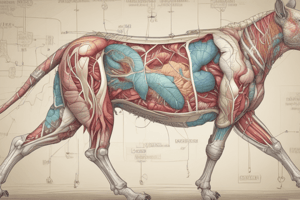Podcast
Questions and Answers
Ποιο είναι το κύριο έργο των ενζύμων όπως το πεπσίνη στο στομάχι;
Ποιο είναι το κύριο έργο των ενζύμων όπως το πεπσίνη στο στομάχι;
- Να απορροφούν τα θρεπτικά συστατικά
- Να απορροφούν το νερό από το φαγητό
- Να μεταφέρουν το χυλό στο λεπτό έντερο
- Να δημιουργούν μια όξινη περιβάλλοντα για την δράση τους (correct)
Ποια είναι η κύρια λειτουργία του λεπτού εντέρου;
Ποια είναι η κύρια λειτουργία του λεπτού εντέρου;
- Να απορροφά θρεπτικά συστατικά (correct)
- Να απορροφά νερό
- Να δημιουργεί κόπρανα
- Να διαλύει το φαγητό
Ποιο είναι το πρωταρχικό καθήκον των μυών του στομάχου;
Ποιο είναι το πρωταρχικό καθήκον των μυών του στομάχου;
- Να απομυκτηρίζουν τη χυμό
- Να αδειάζουν το φαγητό στο πάγκρέας
- Να δημιουργούν ένα οξύ περιβάλλον
- Να χυμοποιήσουν το φαγητό (correct)
Τι ακριβώς περιέχει η χυμός που φθάνει στο λεπτό έντερο;
Τι ακριβώς περιέχει η χυμός που φθάνει στο λεπτό έντερο;
Πώς απαιτείται να είναι το περιβάλλον στο στομάχι για να βοηθήσει στη δράση των ενζύμων;
Πώς απαιτείται να είναι το περιβάλλον στο στομάχι για να βοηθήσει στη δράση των ενζύμων;
Study Notes
Digestion in Biology: From Mouth to Anus
As you chew and swallow food, it embarks on a lengthy journey through your body, undergoing transformations that aid in breaking down nutrients and disposing of waste. This article will guide you through the complex process of digestion, focusing on the main organs involved and the essential roles they play in the conversion of food into energy and waste.
From Mouth to Stomach
When you swallow, food enters the stomach, which secretes hydrochloric acid and enzymes like pepsin to begin breaking down the food particles. The stomach churns the food into a semi-liquid substance called chyme.
The Role of the Stomach
The stomach performs three main tasks:
- Mechanical breakup: The stomach muscles churn the food, breaking it up into smaller pieces.
- Mixing: The stomach mixes the food with digestive juices to facilitate the breakdown of nutrients.
- Acidification: The stomach secretes hydrochloric acid, which creates an acidic environment for the digestive enzymes and microorganisms in the chyme.
From Stomach to Small Intestine
The chyme leaves the stomach and enters the small intestine, which is divided into three sections: the duodenum, jejunum, and ileum. In the small intestine, the chyme is further mixed with bile from the liver and gallbladder, as well as pancreatic juices from the pancreas.
The Role of the Small Intestine
The primary function of the small intestine is to absorb nutrients. The small intestine is lined with microvilli, which dramatically increase the surface area available for nutrient absorption. Nutrients are absorbed through the epithelial cells lining the small intestine and transported into the bloodstream.
From Small Intestine to Large Intestine
After nutrients have been absorbed, the remaining indigestible material moves from the small intestine to the large intestine. The large intestine is made up of the cecum, colon, rectum, and anus.
The Role of the Large Intestine
The primary function of the large intestine is to absorb water from the waste material, concentrating the remaining components into feces. The large intestine is also home to beneficial bacteria that help break down and ferment any remaining food particles. The feces are then stored in the rectum until they are expelled through the anus during defecation.
The Role of the Liver and Gallbladder
The liver produces bile, which is stored in the gallbladder until it is needed to emulsify fats in the small intestine. The gallbladder releases bile into the small intestine as needed.
The Role of the Pancreas
The pancreas secretes enzymes that break down proteins, fats, and carbohydrates in the small intestine. The pancreatic enzymes are essential for the proper digestion and absorption of nutrients.
Conclusion
Digestion is a complex process involving multiple organs that work together to break down food into nutrients that are absorbed by the body. The remaining indigestible material is excreted as waste. Understanding these processes can help us appreciate the intricate design of our bodies and the importance of healthy eating and digestive function.
Studying That Suits You
Use AI to generate personalized quizzes and flashcards to suit your learning preferences.
Description
Explore the intricate journey of food through the digestive system, from the mouth to the anus, and learn about the vital roles played by organs like the stomach, small intestine, and large intestine. Discover how nutrients are absorbed and waste materials are expelled in this comprehensive guide to digestion in biology.




